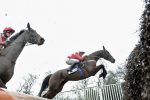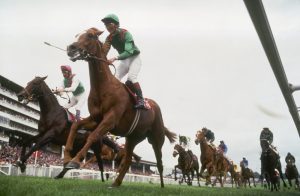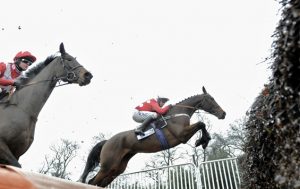He was flame-red with a flashy white face and an exotic name. And to my ten-year-old eyes he was magical.
Shahrastani, the dual Derby victor who passed away recently at the age of 28, was one of the stars of a vintage 1986 season. He was also to ignite a passion for racing and a career in the industry.
After one introductory two-year-old start at Newbury, Shahrastani recorded solid victories in both his Classic preps; the Guardian Classic Trial at Sandown and the Mecca Dante at York. Trained by Sir Michael Stoute and owned by HH The Aga Khan, his stature was growing and there was a lot to like about his attitude and his performance. My pocket money was well-spent as I scoured the Racing Post for news of his progress in the run-up to the Derby at Epsom. My bemused parents could only wonder at this burgeoning interest in a sport they knew little about.
His Derby victory was a masterclass from horse and jockey – smooth and balanced progress throughout the race, traversing the testing undulations of Epsom’s helter-skelter with aplomb. The dark bay sports car that was Dancing Brave was powering at the death, but Shahrastani did not fold, he ran resolute to the line. Those heart-stopping seconds, when in lung-bursting strides he claimed Tesio’s famous piece of wood, were the stuff of dreams for his young fan glued to the television.
Amidst all the discussion after the race, Shahrastani’s next target in the Irish Derby felt oddly like a mission of honour to prove how good he was. Masterfully trained and ridden once again, he arrived at The Curragh at the peak of his formidable powers. With impressive ease, he blew them away at a relentless gallop, strolling home by eight lengths. Vindication was sweet.
He returned in a strong line-up for the King George at Ascot and, while soundly beaten by the extraordinary Dancing Brave, finished a creditable fourth and my devotion remained undimmed.
Rested until the autumn, he reappeared to take his place among the stellar cast of the 1986 Arc. Most observers agreed that with ten Group 1 winners in the field, it was a very special renewal. My abiding memory is of the closing stages where Shardari, Triptych, Bering and Shahrastani ran the race of their lives, all guns blazing in the final shoot-out, while Dancing Brave came fast and late with an assassin’s precision to pick them off. Their bravery was the perfect backdrop to his brilliance, and I could not have been more proud of Shahrastani, a noble fourth.
Retired to stud, my interest in him was just beginning. His stud career started in Kentucky, and ended up in Leicestershire, via Japan and Ireland in between. Following him and his progeny, and being kindly encouraged by so many trainers, studs and sales companies along the way, sowed the seeds of determination to try to work in the industry.
Meeting Shahrastani at long last, in 1999 in Ireland, was a special moment when that unmistakable white face swung my way over the stable door. Visiting him in later years at Walton Fields Stud in Leicestershire was a pleasure, with his stallion’s air of majesty ever present despite advancing age.
There is an empty lead shank now on which a mighty dual Derby winner used to walk, and those closest to him down the years will be feeling the biggest loss.
I owe him and all connected with him a debt of gratitude for almost three decades of enjoyment. The wonderful thing about racehorses is that they can carry everyone’s dreams on their backs.




